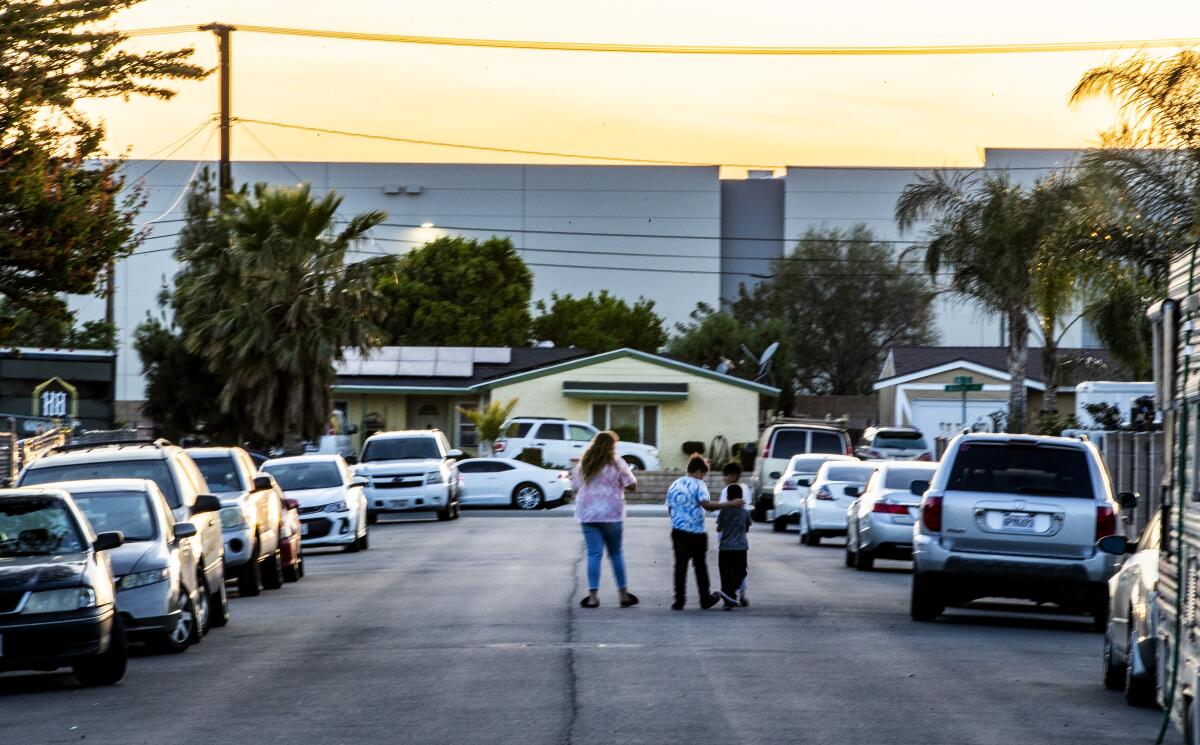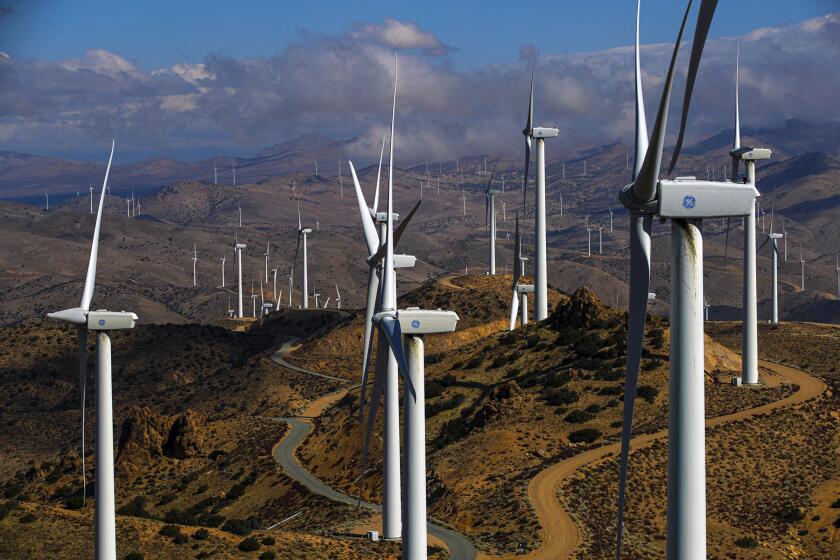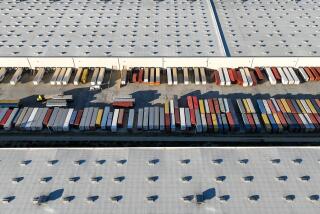As ‘diesel death zones’ spread, pollution regulators place new rules on warehouse industry

Southern California air quality officials have adopted first-of-their-kind rules on warehouse distribution centers in an effort to cut truck pollution, increase electrification and reduce health risks in communities hit hardest by lung-damaging diesel exhaust.
The South Coast Air Quality Management District’s governing board approved the rules Friday on a 9-4 vote after an hours-long public hearing.
The rules apply to nearly 3,000 warehouses across the region and mark the first comprehensive effort to limit the environmental impacts of the booming goods-movement industry. As massive logistics warehouses have proliferated in areas that are disproportionately Black and Latino, increasing numbers of diesel trucks are plying routes closer to homes, schools and neighborhoods that are already burdened with some of the dirtiest air in the nation.
“Today’s adoption of the warehouse rule is a major step towards reducing air pollution and protecting the millions of people directly impacted,” said Wayne Nastri, executive officer of the South Coast air district.
The regulations will have the greatest effect in the Inland Empire, where relatively cheap land within a reasonable drive of the nation’s largest port complex has triggered development of massive distribution and fulfillment centers, including mega-warehouses that exceed 1 million square feet. Dubbed both “America’s shopping cart” and “diesel death zones,” these communities have only grown busier during the COVID-19 pandemic, as online shopping pushes the volume of cargo moving through the region to record levels.
Biden’s plan to cut U.S. greenhouse gas emissions in half is slightly more aggressive than California’s, and is among the world’s most ambitious.
Under the rules, warehouses 100,000 square feet or larger — about the size of two football fields — must take steps to cut or offset emissions associated with their operations or pay a mitigation fee to fund similar air quality improvements nearby.
Republican Ben Benoit, mayor pro tem of the Riverside County city of Wildomar and the newly sworn-in chair of the air quality board, joined the board’s eight Democrats in supporting the measure. Four Republicans voted in opposition. The 13-member board, made up of eight Democrats and five Republicans, consists of elected officials and other appointees from Los Angeles, Orange, Riverside and San Bernardino counties.
The vote followed hours of public testimony, much of it from residents of Riverside, San Bernardino and other inland communities urging action on behalf of children with asthma, relatives with lung cancer and others who struggle to breathe because of the smog and truck pollution.
Mirella Deniz-Zaragoza of the Warehouse Worker Resource Center said the rules would benefit poor and working-class people of color living and working on the front lines of the logistics industry, and called the move a “lifesaving regulation that will ensure industry polluters like Amazon are held accountable and will ensure people who breathe the air and raise families in our communities live longer and healthier lives.”
California plans to launch two climate-tracking satellites into orbit in 2023 to search for ‘super-emitters’ of planet-warming pollution.
Board members also heard from goods movement industry representatives and other business interests who criticized the rules as overreaching and damaging to their bottom lines, while Inland Empire officials such as Fontana Mayor Acquanetta Warren said they would kill warehouse jobs that “sustained us during this COVID period.”
At the same time, the rules garnered support from some labor groups and industries that would benefit from a shift to cleaner technology. A representative for heavy-duty engine manufacturer Cummins spoke in favor of the measure, saying that lower-polluting, natural-gas-fueled trucks are widely available and serviced by local technicians with “living-wage union jobs.”
Republican board members who opposed the move predicted that industry would pass on the costs of compliance, leading to higher prices on groceries and other consumer products. They also argued that the rules would prove ineffective because they do not directly regulate truck pollution, which is the responsibility of state and federal regulators.
San Bernardino County Supervisor Janice Rutherford, a Republican on the air quality board who opposed the regulation, said state emissions rules, technology advancement and the market would bring more zero-emission trucks years from now, “and in the meantime we’re going to perpetuate this rule and cause a lot of pain and a lot of higher costs that will not achieve that goal any faster.”
Los Angeles County Supervisor Sheila Kuehl, who supported the rules, countered that people in the most heavily affected neighborhoods “have not indicated that they’re worried about the cost of their cereal; they’re worried about their lungs.”
An air district analysis found that large warehouses are disproportionately concentrated in Black and Latino communities. The population living within half a mile of at least one large warehouse is 62.1% Latino and 7.6% Black, compared with a population that is 45.4% Latino and 6.5% Black across the four-county region. Warehouse-adjacent communities have higher rates of asthma, heart attacks and poverty, the analysis found.
Vanessa Delgado, a former state senator and Democrat who serves on the air board, called the regulations “an important step toward measurable air quality improvements” that would save lives “in mostly disadvantaged communities of color.”
The environmental impacts of the growing logistics industry are unevenly distributed. Though L.A. County has the most warehouses, they are smaller and older than those in the Inland Empire, where much of the recent growth has been concentrated.
A report by the Inland Empire-based People’s Collective for Environmental Justice and the University of Redlands examined e-commerce sales to find that the communities with the greatest concentrations of warehouses, such as Ontario, Fontana and San Bernardino, do the least online shopping among large cities in the Greater L.A. region.
The impacts of warehouse-adjacent communities are often cumulative, as multiple facilities rise in the same neighborhoods, piling on more truck traffic and lung-damaging diesel particulate matter than they would individually, said Ivette Torres, an author of the report and environmental science researcher who lives in Moreno Valley.
“You don’t only have the warehouse next door but the one down the street,” Torres said. “They add up and they add up. And then you have hundreds or a thousand trucks passing through.”
Despite dramatic improvements in air quality over the decades, Southern California still has the nation’s worst air pollution and has seen its progress fighting smog stall and reverse in recent years. In 2020 the region logged 157 bad air days for ozone — the invisible, lung-searing gas in smog — the highest number since the mid-1990s. Inland communities, many of the same ones where warehouse development is booming, have the most persistently high levels of ozone.
The warehouse regulations are a critical piece of state and local officials’ efforts to reverse a recent slide in air quality. To meet federal smog-reduction deadlines, the South Coast basin must slash smog-forming nitrogen oxide emissions 45% below baseline levels by 2023 and 55% more by 2031.
Trucks are the largest source of those emissions, and warehouses are responsible for more of them than any other sector — about as much as all stationary facilities in the region, including all oil refineries and power plants combined. Implementation of the rules will reduce nitrogen oxide emissions from warehouses by 1½ to 3 tons a day over the next decade, a decrease of 10% to 15%, the air district projects.
Under the rules, facilities must choose from a menu of pollution reduction and mitigation options, such as using electric or natural-gas-fueled trucks, installing charging stations, erecting rooftop solar panels or putting air filters in neighboring schools and child-care centers — a measure that some board members complained would not reduce pollution, only exposure to it.
The air district estimates that compliance with the rules could cost hundreds of millions of dollars but that those costs are outweighed by health benefits worth about three times that amount, including the prevention of hundreds of early deaths from air pollution as well as thousands of fewer asthma attacks and missed work days over the first 10 years.
In adopting the measure, the board overcame opposition from cargo-moving industries, which urged officials to reject the regulation, saying it would restrict job growth, fail to clean the air, amount to a tax and exceed the air district’s legal authority. State and local authorities disputed those claims. An analysis by state Atty. Gen. Rob Bonta’s office affirmed the air district’s authority, and its obligation under the Clean Air Act, to adopt a regulation targeting warehouse emissions. It also dispelled the notion that it was a tax.
The air quality board’s decision to regulate warehouses follows more than a decade of proposals to use its authority under state law to regulate ports and other freight-handling facilities as “indirect sources” of pollution and is the first such rule to come out of a 2017 smog-reduction plan designed to clean the region’s air to meet federal health standards. The agency has approved voluntary emissions reduction agreements with commercial airports in the region but has not acted when it comes to ports, railyards and new development projects.
More to Read
Sign up for Essential California
The most important California stories and recommendations in your inbox every morning.
You may occasionally receive promotional content from the Los Angeles Times.











